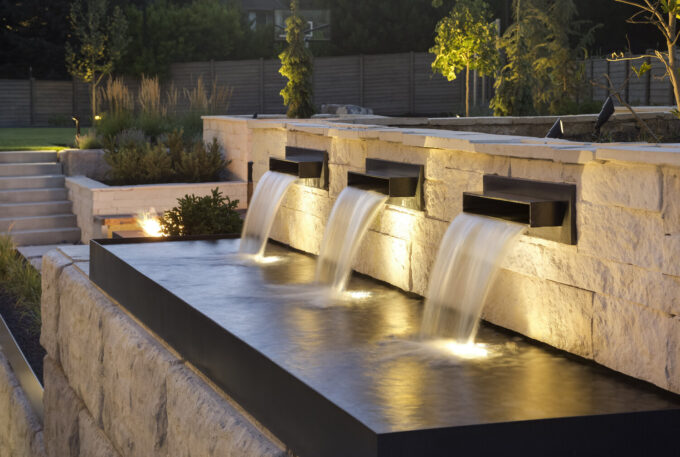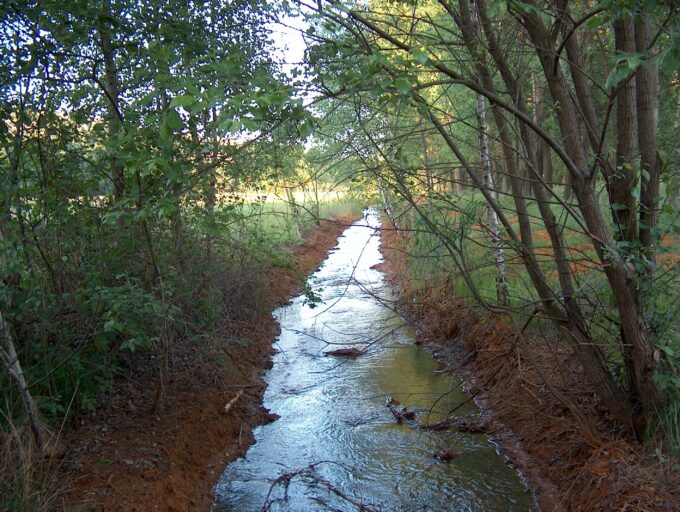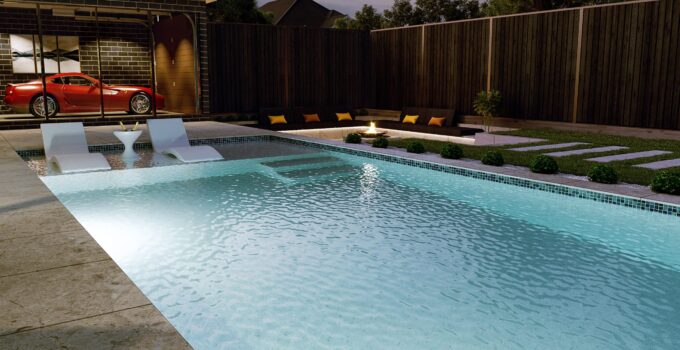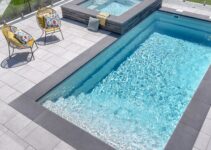Garden water features have been around for years, but there has been an increase in homeowners taking a more modern design approach when installing their own. Your garden space can be elevated into something far more interesting with the addition of rills, hot tubs, swimming pools and natural pools. To help with your own water feature designs, we have put a guide together to help inspire and inform you on the benefits of adding water to a garden. Let’s look…
Water Features

Source: outdoorelementsdesign.com
Running water features can help to create a sense of calmness, peace, and tranquillity, and are used extensively in Japanese style gardens. The peaceful sound of trickling water is incredibly soothing and can help us to enjoy our surroundings more. Installing a water feature with flowing water will create a feeling of ease and enhance the ambiance around you. You can start simple, with bird baths, fountains, and figurine statues.
As well as providing this peaceful auditory texture, water fountains can also bring an ornamental focus to your garden. Because water has a unique fluid motion, this can provide a focal point within stark areas, blending the hard lines of architectural features such as trellising, pergolas, garden furniture and NeoTimber composite decking.
Building Ponds

Source: thisoldhouse.com
You can combine your water features by installing ponds into your garden. Again, ponds can help to break up or frame your outdoor space and can be a gorgeous focal point, breaking up the more linear design conventions most modern gardens abide by. If you have young children or small animals, make sure that your pond is partitioned and bordered effectively, to avoid any accidents.
A pond feature can also provide a self-sustaining ecosystem for a large variety of different wildlife and nature, helping to create the feeling of a “wilder” garden. You can even fill your pond with fish for a pop of intense colour. Most pond fish are relatively easy to care for, only needing food, space and the appropriate provisions during the autumn and winter months.
Rills And Streams

Source: de.wikipedia.org
A garden rill is a very shallow canal of water, perfect for bordering the perimeter of your garden space. A rill can either be filled with still or flowing water, though if it is flowing, you can connect the channel to an existing pond or natural pool. You can surround the edge of your rill with stones or planting, to make it appear more like a natural extension of your garden space.
A rill can even be placed within the middle of a flat garden space, to make a gorgeous, symmetrical design feature. A rill needs to be around 20cm deep, and at least 60-90cm wide. If you want a wider stream, it’s easier to create a flow by taking advantage of any gradual slopes in your garden. If you have a flat garden, you can easily create a gradient by building up soil or rocks.
Natural Pools

Source: bhg.com
Natural pools are becoming more of a must-have for more luxury gardens, relying on filters and moving water to do all the heavy lifting for unwanted algae and other surface weeds. They are constructed with walls that keep out the soil and can be created either from scratch or by converting pre-existing swimming pools.
To help create a natural look, we recommend using water plants growing both on the surface and perimeter of the pool, to blend the border of the pool into your garden space. These plants also have the functional benefit of naturally filtering the water, making the pool safe to swim in.
Hot Tubs

Source: thisoldhouse.com
Adding a hot tub to a garden space can really create a relaxing area that can be enjoyed all year around, especially during those colder winter months. There are plenty of inspirational tips and tricks on how to install a hot tub within a garden. We would recommend using deck boards underneath your hot tub to better support it, so it’s not just sitting on the soft earth.
If you do choose to place a hot tub on top of a decking area, it is important to choose deck boards designed to withstand any heavier items placed on top of them. Additionally, it is important to weatherproof the subframe beneath, so it doesn’t rot, by either treating it with preservatives or using joist tape to protect the wood.
Swimming Pools

Source: en.wikipedia.org
If your budget or space allows it, a swimming pool is the ultimate water feature for your garden. Remember, a pool does not necessarily even need to be particularly large to allow you to benefit from regular swimming. You can use the pool as the main focal point of your garden, surrounding it with outdoor seating for you to enjoy your space.
There are many health benefits to swimming, but one of the main ones is that it helps to relieve stress. Stress builds up within your body and a way of releasing it is by regular exercise. Swimming is especially good at this, because it uses your whole body, releasing more endorphins which can help to lighten your mood. We all like to feel calmer, so why not create an area in your garden for you to be more regularly active, so you can achieve this?
To conclude, adding just one of these styles can really help create a different zone within your garden. The size and complexity of water features depend on your budget and ability to handle maintenance levels, but any of these can be placed within any garden with a bit of creative design and careful planning.
Consider the overall aesthetic and mood you are trying to create before choosing which water features would be appropriate for your space. Water features can correspond with one another in interesting ways. Rills and streams can easily flow into natural pools or ponds, and you can get creative in the ways you can hide pumps or piping, by installing rockery or other ornamental features. By planning your projects thoroughly, you too may benefit from the peaceful, relaxing tranquillity offered by the sound of water in your garden space.







